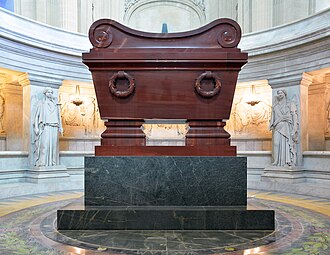Earth:Shoksha quartzite
[ ⚑ ] 61°29′N 35°2′E / 61.483°N 35.033°E
Shoksha quartzite, Shoksha porphyry, or crimson quartzite (Russian: малиновый кварцит, literally "raspberry quartzite") is quartzose sandstone of deep red color variously described as purple or crimson resembling true porphyry.[1] It is named after Shoksha, Karelia (ru), a village in Prionezhsky District, Karelia, Russia, close to its deposits. Currently it is mined mostly in the nearby miner's settlement of Kvartzitny (ru) by Lake Onega.[2] Its shades of red color is due to iron oxides.[1]
This durable and expensive material was used for decoration of many Russian palaces, cathedrals and sculptures.[2]
Scrap crimson quartzite is of various utility in Russia. Due to its high heat resistance it is used for fireplaces in banyas and saunas. Its durability makes it suitable for pavements. Due to its aesthetic qualities it is used minor decorations, etc.[1][3]
In Soviet times the major usage of Shoksha quartzite was in glass industry, for grinding balls and linings used in grinders for grinding mineral components for glass.[4]
In 1981 the estimated volume of the Shiksha quartzite field was over 1.3 million cubic meters.[4]
Notable uses
- Napoleon's tomb[2]
- Decorations of the lift hall of Hilton Moscow Leningradskaya, one of "Stalinist skyscrapers"[5]
- Several elements of Saint Isaac's Cathedral, including details of the bust to the cathedral's architect Auguste de Montferrand[5][2]
- Friezes in the main façade of Saint Michael's Castle[5][2]
- Pedestal of the Tsar Nicholas I monument[5]
- Letters "LENIN" and some other elements of Lenin's Mausoleum[6]
References
- ↑ 1.0 1.1 1.2 Малиновый кварцит
- ↑ 2.0 2.1 2.2 2.3 2.4 Шокшинский кварцит
- ↑ Малиновый кварцит. Месторождение, использование
- ↑ 4.0 4.1 Шокшинский кварцит
- ↑ 5.0 5.1 5.2 5.3 A. Bulakh, “Porphyries” from Russia and Sweden used in St Petersburg and Russian “porphyry” used in Paris: misuse of a geological term for some possible candidate as a Global Heritage Stone Resource, doi:10.18814/epiiugs/2015/v38i2/007
- ↑ Алексей Абрамов, Правда и вымыслы о кремлевском некрополе и Мавзолее
Further reading
- A detailed description of Shoksha quartzite, its varieties and quarries may be found in the 1927 Soviet book Stone Construction Materials of the Onega Region (Каменные строительные материалы Прионежья), Part I: Quartzites and Sandstones, pp. 28-33 by Vladimir Timofeev (geologist) (ru) (public domain)
- Александра Валентиновна Рахманова, Alexandra Rakhmanova, "Малиновый кварцит в историко-культурном наследии России и зарубежья", Серия «Геология докембрия» Трудов Карельского НЦ РАН , no.2, 2021, pp. 62-73, doi:10.17076/geo1213
 |



